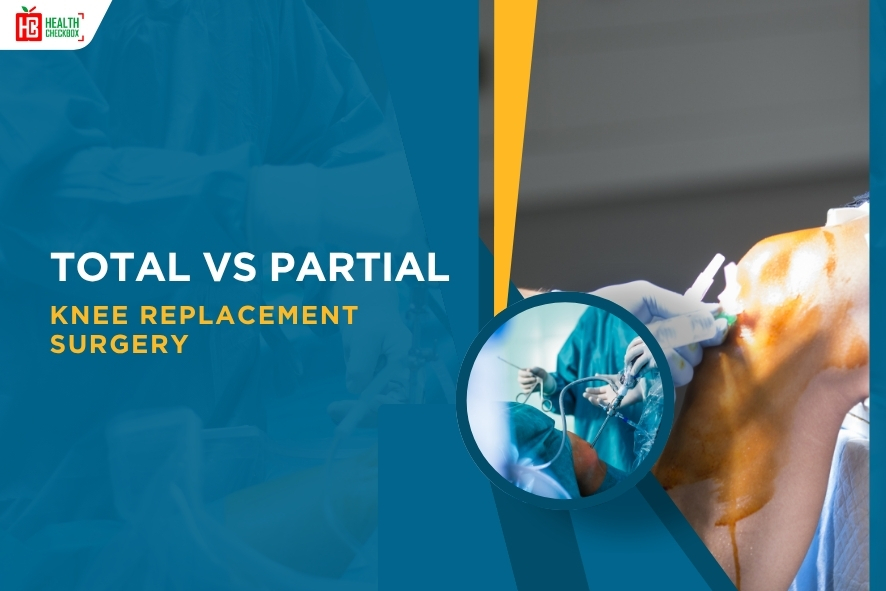People of all ages, especially those over 50, suffer from knee pain and diseases like osteoarthritis and arthritis. These conditions can greatly impact daily living and make walking, climbing stairs, and even standing for long periods a challenge for the elderly. Obesity, trauma, and prolonged stress can also contribute to this condition. In this blog, we will understand the difference between total vs partial knee replacement surgery and the risks associated with these surgeries.
Nevertheless, both treatments aim to reduce pain and restore knee flexibility, although the approaches taken by the two medical surgeries may differ. Your age, lifestyle, and specific medical conditions will determine which option is best for you.
What is Total Knee Replacement?
Total knee replacement (TKR), or total knee arthroplasty, involves replacing all three compartments of the knee joint:
- The medial (inside)
- Lateral (outside)
- Patellofemoral (under the kneecap)
The implant is normally made of a high-quality metal and plastic combination. This procedure best suits those patients who have severe knee arthritis and affects all 3 compartments of the knee.
What is Partial Knee Replacement?
A less invasive option that works well for localized degeneration is partial knee replacement (PKR), also referred to as unicompartmental knee arthroplasty (UKA). It replaces only the damaged compartment, typically the medial or lateral, while leaving the rest of the knee, including the ligaments and cartilage intact.
To put it in simple terms, a partial knee resurfacing preserves the two healthy compartments of the knee. It best suits those individuals whose only 1 knee compartment is hurt, whereas the other 2 are intact.
Benefits Associated with Total Knee Replacement
TKR is a medical surgery that aims to decrease the pain and inflammation due to severe knee arthritis, a critical knee injury, or trauma. This surgery is a major medical procedure and the patient’s commitment is crucial in terms of time, liveliness, and the resources. Let us discuss the benefits below:
- Relief from Pain: It is a major advantage of the TNR procedure. Most of the patients report a significant improvement in their quality of life. With an advancement in medical science the high-quality implant makes the internal motion painless and smooth.
- A better Mobility: The patient after the surgery is able to walk, climb stairs, and carry out other daily tasks that were previously challenging as there is an improved overall mobility in the joint. This may have a substantial effect on the patients capacity for self-sufficiency and consequently their physical and mental health.
- Long-lasting Results: Many patients benefit from the surgery for many years to come. Some artificial joints can last up to 20 years. Knee surgery has a very high patient satisfaction rate and is very successful.
- Minimal invasive Procedure: The cuts involved are tiny, and a short recovery time enables a quick and smooth recovery.
Benefits Associated with Partial Knee Replacement(Knee Resurfacing)
The benefits of a partial knee replacement include:
- Usually, a small incision is made.
- A minuscule pain, a brief hospital stay, and a fast recovery.
- Low surgical complications such as contamination, clots from blood, heart damage, stroke, and death.
- Better functional outcomes reported by patients.
- Lower rate of early re-operations.
Risks Associated with Total vs Partial Knee Replacement Surgery
The risks associated with the above 2 procedures include:
- A partial knee replacement normally has a higher revision (repeat or redo) rate than total knee replacement.
- A PKR risks functions getting worse after revision of PKR than TKR.
- Revision surgery in case of PKR can be more complicated than primary surgery as the need to remove the implant may require extra effort due to its tight attachment to the knee bone.
Candidates for Partial Knee Replacement
In 1998, two healthcare experts (Drs. Scott and Kozinn) developed a benchmark for the assessment of patients appropriate for partial knee replacement. Factors that favor this procedure in the elderly:
- More than 60 years old
- Under 180 lb. or 80 kg
- Less active individuals
- A reasonable range of motion before surgery
- Has minimal knee deformation
Note: Individuals who have inflammatory arthritis, for example, rheumatoid arthritis are unsuitable candidates for partial knee replacement.
Deciding Factors for TKR and PKR Surgery
Choice for the procedure is dependent on several factors that include:
- Arthritis and its Extent: Doctors mainly recommend TKR when the injury covers the total knee whereas PKR is done on a specified region of the knee.
- A Stable Knee: PKR is possible only with an intact ligament else doctors recommend TKR.
- Patient’s Age: PKR is mainly for young individuals, active patients with low arthritis.
What is the Recovery Time in Both Surgeries?
The recovery time depends on the individual’s health and may vary from person to person. As PKR is less invasive, recovery is quick and of less discomfort.
| Services | Total knee replacement recovery | Partial knee replacement recovery |
| Stay in the hospital | 3 to 5 days | 1 to 2 days |
| Time spent with walker or walking with a support | 2 to 3 weeks | 1 to 2 weeks |
| Physical therapy | 6 to 12 weeks | 4 to 6 weeks |
| Return to daily activity | 3 to 6 months | 6 to 8 weeks |
| Full recovery | 6 to 12 months | 3 to 6 months |
Conclusion
The degree of knee joint damage, your lifestyle, and your long-term goals will all play a role in your decision between PKD and TKR. Both total vs partial knee replacement surgery are viable options for treating knee joint damage. While the latter is for specific regions of the knee, the former is a comprehensive solution for severe arthritis.
Ultimately, a qualified bone surgeon best decides the right option. They will assess your X‑rays, physical exam alignment, ligament strength, walking style, age, health status, and activity goals. Your involvement and understanding of each option are critical for long‑term success.

